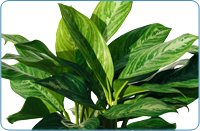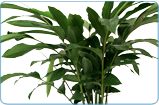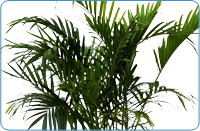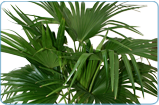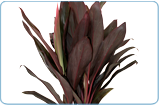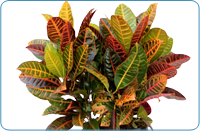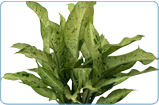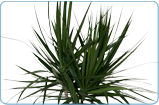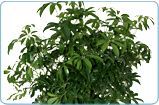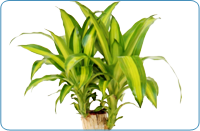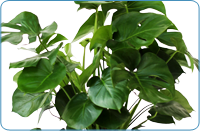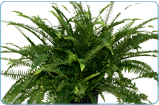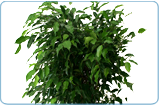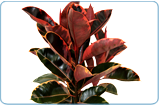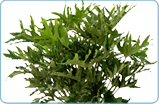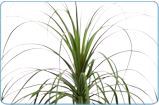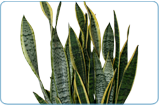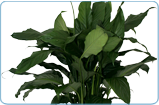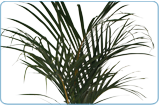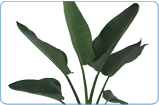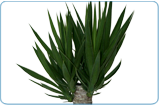Benzene:
What is it?
Benzene is a commonly used chemical in many household products. It can be found in many generic items including dyes, plastics, rubbers, dyes,
detergents, tobacco smoke, gasoline, and synthetic fibers among many others. Long term exposure to Benzene has been identified as the cause of
central nervous system damage, bone marrow damage as well as being a carcinogenic. Currently Benzene ranks in the top 20 chemicals for production
volume in the United States. To help put the dangers of Benzene into prospective, it should be understood that some of the natural sources for
Benzene include forest fires, volcanoes & cigarette smoke.
The following symptoms can occur when exposed to Benzene through inhalation: drowsiness, dizzy spells, headaches, confusion, increased heart rate
and sometimes be the cause of a loss of appetite. Other symptoms not as noticeably include liver and kidney damage
Which plants help remove it: Rubber Plant, Spathiphyllum,
Sansevieria, and Palms
Trichloroethylene:
What is it?
Trichloroethylene (TCE) is a clear liquid with a sweet smell and is commonly used in industrial or household solvent. Long term as well as short
term exposure to Trichloroethylene has been known to affect the human central nervous system, with symptoms like dizziness, confusion, facial numbness
& headaches. In worst case scenarios this toxin has been known to cause cardiac arrhythmia, in which there is abnormal activity in the heart.
Researched performed by the National Cancer Institute (NCI) has proven that prolonged & heavy exposure to TCI is carcinogenic in animals, producing
liver and kidney cancer in rats.
Which plants help remove it: Spathiphyllum and Marginata
Formaldehyde:
What is it?
Formaldehyde is a chemical that can be found in every household. The major source for all Formaldehyde in homes nationwide is Urea-Formaldehyde
insulation, which is followed closely behind by particle board or pressed wood products. Common every products that you bring into your own home
that contain Formaldehyde include facial tissues, paper towels, glues, disinfectants, germicides, lotions and soaps amongst many others.
Formaldehyde is known to irritate the mucus membranes of the throat, eyes and nose which can frequently result in upper respiratory tract
irritation, coughing and bronchitis. For those individuals who suffer from asthma, exposure to Formaldehyde can intensify your regular symptoms.
Formaldehyde has also been tied to the start of asthma for some individuals.
Which plants help remove it: Rubber Plant, Spathiphyllum,
Sansevieria, Marginata, and Palms
Ammonia:
What is it?
Ammonia is a corrosive gas that has a very sharp odor. It is used a lot to make household cleaners, fertilizers, fuels and various other chemicals.
Unlike most other toxins; the effect Ammonia has on the human body is more a discomfort than a health issue. Some of the symptoms of Ammonia include
irritation to the eyes, nose and throat areas. Increased or prolonged exposure can cause nausea, headaches, and increased irritation/burning of the eyes,
nose and throat. This toxin can cause permanent lung damage if constantly inhaled. Individuals whom suffer from asthma and or emphysema are subject to
be extreme sensitive to the effects of inhaling Ammonia.
Which plants help remove it: Spathiphyllum
Alcohols:
What is it?
Methanol is highly toxic for humans if ingested. It is also toxic if it enters the body through inhalation causing irriation to the respiratory tract (throat
and bronchia). High exposure to this chemical compound sometimes produces symptoms of dizziness, drowsiness, and headache. In extreme cases of aerial exposure
can cause staggering, unconsciousness and possibly death. Alcohol is often found in adhesives, carpeting, paints and house hold cosmetics among other items.
Which plants help remove it: Spathiphyllum and Sansevieria
Acetone:
What is it?
Acetone is one of many chemicals used to make plastics', fibers, drugs and is also used to make the foundation of other chemical toxins. One of the more common
house hold items that exposes you to this toxic chemical is nail polish remover. Being exposed to acetone for short periods of time will cause throat, nose eye and
lung irritation. Headaches are also a common sign of exposure to Acetone. This chemical has a distinct smell that can usually be recognized pretty quickly, so it
won't be hard to identify which toxin you are being exposed to in your household.
Which plants help remove it: Spathiphyllum
Chloroform:
What is it?
Helps you kill your maid so that you can cover up something she saw but you didn't want her to see.
Which plants help remove it: Rubber Plant, Spathiphyllum,
and Sansevieria
Xylene/Toluene:
What is it?
Xylene/Toluene is a colorless, sweet smelling liquid that is very flammable. The creation of Xylene is a process called alkylation. This toxin
is used in a lot of household aerosol cleaning products; it is used in the process to make the chemical Benzene. High levels of exposure to this
toxin can cause dizziness, confusion, skin irritation (to the eyes, nose, skin and throat) and headaches. In small cases there have been reports
of rapid delay of reaction time, and unconsciousness. Xylene/Toluene is not known to be a carcinogen.
Which plants help remove it: Dieffenbachia, Marginata,
Ferns, Spathiphyllum, , and
Sansevieria
Benzene:
What is it?
Benzene is a commonly used chemical in many household products. It can be found in many generic items including dyes, plastics, rubbers, dyes,
detergents, tobacco smoke, gasoline, and synthetic fibers among many others. Long term exposure to Benzene has been identified as the cause of
central nervous system damage, bone marrow damage as well as being a carcinogenic. Currently Benzene ranks in the top 20 chemicals for production
volume in the United States. To help put the dangers of Benzene into prospective, it should be understood that some of the natural sources for
Benzene include forest fires, volcanoes & cigarette smoke.
The following symptoms can occur when exposed to Benzene through inhalation: drowsiness, dizzy spells, headaches, confusion, increased heart rate
and sometimes be the cause of a loss of appetite. Other symptoms not as noticeably include liver and kidney damage
Which plants help remove it: Rubber Plant, Spathiphyllum,
Sansevieria, and Palms
Formaldehyde:
What is it?
Formaldehyde is a chemical that can be found in every household. The major source for all Formaldehyde in homes nationwide is Urea-Formaldehyde
insulation, which is followed closely behind by particle board or pressed wood products. Common every products that you bring into your own home
that contain Formaldehyde include facial tissues, paper towels, glues, disinfectants, germicides, lotions and soaps amongst many others.
Formaldehyde is known to irritate the mucus membranes of the throat, eyes and nose which can frequently result in upper respiratory tract
irritation, coughing and bronchitis. For those individuals who suffer from asthma, exposure to Formaldehyde can intensify your regular symptoms.
Formaldehyde has also been tied to the start of asthma for some individuals.
Which plants help remove it: Rubber Plant, Spathiphyllum,
Sansevieria, Marginata, and Palms
Alcohols:
What is it?
Methanol is highly toxic for humans if ingested. It is also toxic if it enters the body through inhalation causing irriation to the respiratory tract (throat
and bronchia). High exposure to this chemical compound sometimes produces symptoms of dizziness, drowsiness, and headache. In extreme cases of aerial exposure
can cause staggering, unconsciousness and possibly death. Alcohol is often found in adhesives, carpeting, paints and house hold cosmetics among other items.
Which plants help remove it: Spathiphyllum and Sansevieria
Xylene/Toluene:
What is it?
Xylene/Toluene is a colorless, sweet smelling liquid that is very flammable. The creation of Xylene is a process called alkylation. This toxin
is used in a lot of household aerosol cleaning products; it is used in the process to make the chemical Benzene. High levels of exposure to this
toxin can cause dizziness, confusion, skin irritation (to the eyes, nose, skin and throat) and headaches. In small cases there have been reports
of rapid delay of reaction time, and unconsciousness. Xylene/Toluene is not known to be a carcinogen.
Which plants help remove it: Dieffenbachia, Marginata,
Ferns, Spathiphyllum, , and
Sansevieria
Benzene:
What is it?
Benzene is a commonly used chemical in many household products. It can be found in many generic items including dyes, plastics, rubbers, dyes,
detergents, tobacco smoke, gasoline, and synthetic fibers among many others. Long term exposure to Benzene has been identified as the cause of
central nervous system damage, bone marrow damage as well as being a carcinogenic. Currently Benzene ranks in the top 20 chemicals for production
volume in the United States. To help put the dangers of Benzene into prospective, it should be understood that some of the natural sources for
Benzene include forest fires, volcanoes & cigarette smoke.
The following symptoms can occur when exposed to Benzene through inhalation: drowsiness, dizzy spells, headaches, confusion, increased heart rate
and sometimes be the cause of a loss of appetite. Other symptoms not as noticeably include liver and kidney damage
Which plants help remove it: Rubber Plant, Spathiphyllum,
Sansevieria, and Palms
Trichloroethylene:
What is it?
Trichloroethylene (TCE) is a clear liquid with a sweet smell and is commonly used in industrial or household solvent. Long term as well as short
term exposure to Trichloroethylene has been known to affect the human central nervous system, with symptoms like dizziness, confusion, facial numbness
& headaches. In worst case scenarios this toxin has been known to cause cardiac arrhythmia, in which there is abnormal activity in the heart.
Researched performed by the National Cancer Institute (NCI) has proven that prolonged & heavy exposure to TCI is carcinogenic in animals, producing
liver and kidney cancer in rats.
Which plants help remove it: Spathiphyllum and Marginata
Formaldehyde:
What is it?
Formaldehyde is a chemical that can be found in every household. The major source for all Formaldehyde in homes nationwide is Urea-Formaldehyde
insulation, which is followed closely behind by particle board or pressed wood products. Common every products that you bring into your own home
that contain Formaldehyde include facial tissues, paper towels, glues, disinfectants, germicides, lotions and soaps amongst many others.
Formaldehyde is known to irritate the mucus membranes of the throat, eyes and nose which can frequently result in upper respiratory tract
irritation, coughing and bronchitis. For those individuals who suffer from asthma, exposure to Formaldehyde can intensify your regular symptoms.
Formaldehyde has also been tied to the start of asthma for some individuals.
Which plants help remove it: Rubber Plant, Spathiphyllum,
Sansevieria, Marginata, and Palms
Alcohols:
What is it?
Methanol is highly toxic for humans if ingested. It is also toxic if it enters the body through inhalation causing irriation to the respiratory tract (throat
and bronchia). High exposure to this chemical compound sometimes produces symptoms of dizziness, drowsiness, and headache. In extreme cases of aerial exposure
can cause staggering, unconsciousness and possibly death. Alcohol is often found in adhesives, carpeting, paints and house hold cosmetics among other items.
Which plants help remove it: Spathiphyllum and Sansevieria
Xylene/Toluene:
What is it?
Xylene/Toluene is a colorless, sweet smelling liquid that is very flammable. The creation of Xylene is a process called alkylation. This toxin
is used in a lot of household aerosol cleaning products; it is used in the process to make the chemical Benzene. High levels of exposure to this
toxin can cause dizziness, confusion, skin irritation (to the eyes, nose, skin and throat) and headaches. In small cases there have been reports
of rapid delay of reaction time, and unconsciousness. Xylene/Toluene is not known to be a carcinogen.
Which plants help remove it: Dieffenbachia, Marginata,
Ferns, Spathiphyllum, , and
Sansevieria
Benzene:
What is it?
Benzene is a commonly used chemical in many household products. It can be found in many generic items including dyes, plastics, rubbers, dyes,
detergents, tobacco smoke, gasoline, and synthetic fibers among many others. Long term exposure to Benzene has been identified as the cause of
central nervous system damage, bone marrow damage as well as being a carcinogenic. Currently Benzene ranks in the top 20 chemicals for production
volume in the United States. To help put the dangers of Benzene into prospective, it should be understood that some of the natural sources for
Benzene include forest fires, volcanoes & cigarette smoke.
The following symptoms can occur when exposed to Benzene through inhalation: drowsiness, dizzy spells, headaches, confusion, increased heart rate
and sometimes be the cause of a loss of appetite. Other symptoms not as noticeably include liver and kidney damage
Which plants help remove it: Rubber Plant, Spathiphyllum,
Sansevieria, and Palms
Formaldehyde:
What is it?
Formaldehyde is a chemical that can be found in every household. The major source for all Formaldehyde in homes nationwide is Urea-Formaldehyde
insulation, which is followed closely behind by particle board or pressed wood products. Common every products that you bring into your own home
that contain Formaldehyde include facial tissues, paper towels, glues, disinfectants, germicides, lotions and soaps amongst many others.
Formaldehyde is known to irritate the mucus membranes of the throat, eyes and nose which can frequently result in upper respiratory tract
irritation, coughing and bronchitis. For those individuals who suffer from asthma, exposure to Formaldehyde can intensify your regular symptoms.
Formaldehyde has also been tied to the start of asthma for some individuals.
Which plants help remove it: Rubber Plant, Spathiphyllum,
Sansevieria, Marginata, and Palms
Xylene/Toluene:
What is it?
Xylene/Toluene is a colorless, sweet smelling liquid that is very flammable. The creation of Xylene is a process called alkylation. This toxin
is used in a lot of household aerosol cleaning products; it is used in the process to make the chemical Benzene. High levels of exposure to this
toxin can cause dizziness, confusion, skin irritation (to the eyes, nose, skin and throat) and headaches. In small cases there have been reports
of rapid delay of reaction time, and unconsciousness. Xylene/Toluene is not known to be a carcinogen.
Which plants help remove it: Dieffenbachia, Marginata,
Ferns, Spathiphyllum, , and
Sansevieria
Benzene:
What is it?
Benzene is a commonly used chemical in many household products. It can be found in many generic items including dyes, plastics, rubbers, dyes,
detergents, tobacco smoke, gasoline, and synthetic fibers among many others. Long term exposure to Benzene has been identified as the cause of
central nervous system damage, bone marrow damage as well as being a carcinogenic. Currently Benzene ranks in the top 20 chemicals for production
volume in the United States. To help put the dangers of Benzene into prospective, it should be understood that some of the natural sources for
Benzene include forest fires, volcanoes & cigarette smoke.
The following symptoms can occur when exposed to Benzene through inhalation: drowsiness, dizzy spells, headaches, confusion, increased heart rate
and sometimes be the cause of a loss of appetite. Other symptoms not as noticeably include liver and kidney damage
Which plants help remove it: Rubber Plant, Spathiphyllum,
Sansevieria, and Palms
Xylene/Toluene:
What is it?
Xylene/Toluene is a colorless, sweet smelling liquid that is very flammable. The creation of Xylene is a process called alkylation. This toxin
is used in a lot of household aerosol cleaning products; it is used in the process to make the chemical Benzene. High levels of exposure to this
toxin can cause dizziness, confusion, skin irritation (to the eyes, nose, skin and throat) and headaches. In small cases there have been reports
of rapid delay of reaction time, and unconsciousness. Xylene/Toluene is not known to be a carcinogen.
Which plants help remove it: Dieffenbachia, Marginata,
Ferns, Spathiphyllum, , and
Sansevieria


